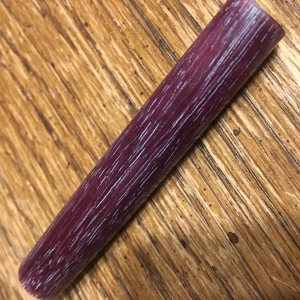mgatten
Member
I finished a pen in purpleheart and was disappointed to notice a few little white "threads" in the grain when I was done.
I assumed that I must have overheated the CA glue a little bit.
Annoyed, I sanded all the finish off. I was very aggressive about it because I needed to make sure there was no CA left. I sanded with 100 grit until ALL hint of CA was gone, including making sure there were no white threads. I figured I might make it too small past the bearings, but nothing that a ridiculous number of coats of CA wouldn't fix.
I then cleaned it with denatured alcohol. It looked perfect. No white anywhere.
Then I started sanding with 150, 220, 320, 400, 600 and then 800.
But the white threads came back with a VENGEANCE!! Now they are all OVER the thing, and LONG! The tube pictured has had no CA finish. There is no superglue there to have overheated.
What the heck?
Is this normal for some purpleheart? Is there a way to avoid it?

View in Gallery
I assumed that I must have overheated the CA glue a little bit.
Annoyed, I sanded all the finish off. I was very aggressive about it because I needed to make sure there was no CA left. I sanded with 100 grit until ALL hint of CA was gone, including making sure there were no white threads. I figured I might make it too small past the bearings, but nothing that a ridiculous number of coats of CA wouldn't fix.
I then cleaned it with denatured alcohol. It looked perfect. No white anywhere.
Then I started sanding with 150, 220, 320, 400, 600 and then 800.
But the white threads came back with a VENGEANCE!! Now they are all OVER the thing, and LONG! The tube pictured has had no CA finish. There is no superglue there to have overheated.
What the heck?
Is this normal for some purpleheart? Is there a way to avoid it?

View in Gallery
